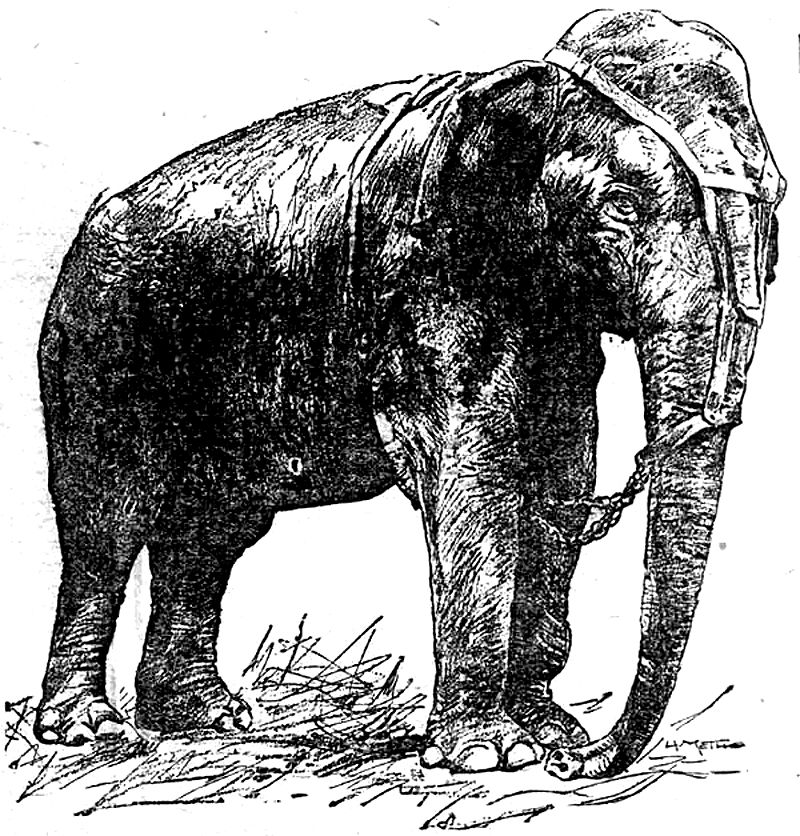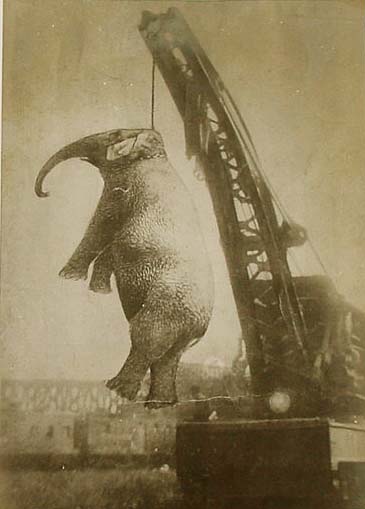Performing elephants were very common in circuses during the 19th and 20th centuries. Circus owners would often treat these animals with cruelty and subject them to great physical and mental stress. Under the strain of captivity and regular performance, elephants turned increasingly violent and turned upon their trainers, and at times, upon the spectators. If the elephant, because of its temperament, was deemed unsuitable to continue performing in the shows, it was put to death, sometimes in spectacular fashion.

Poster of the Forepaugh & Sells Brothers circus. Photo: trialsanderrors/Wikimedia
Topsy was a female Asian elephant who was captured in the jungles in Southeast Asia in 1875 and sold to Adam Forepaugh, owner of the Forepaugh Circus. Forepaugh secretly smuggled the elephant into the United States and began to claim that it was “the only baby elephant ever born on American soil.” But the elephant trader who sold Topsy to Forepaugh spilled the beans to P. T. Barnum and Barnum exposed the hoax publicly.
Topsy grew up into a tall elephant—10 feet high and 20 feet long, and weighed between 3.6 to 5.4 metric tons. She was known for her foul mood. In 1902, a drunk spectator named James Fielding Blount wandered into the menagerie tent of the Forepaugh & Sells Brothers' Circus in Brooklyn and began teasing Topsy, throwing sand at her face and then burning the tip of her trunk with a lit cigar. Topsy grabbed Blount by her trunk and threw him to the ground and then crushed him with her head and foot.
The killing of Blount created a sensation in Brooklyn and newspapers tried to malign Topsy’s reputation as a man-killer, claiming that she had killed up to 12 men. Some accounts suggested that she killed two circus workers, previously. In June 1902, another spectator tried to tickle Topsy behind the ear with a stick. Topsy seized the man around the waist with her trunk, hoisted him high in the air and threw him back down. After this incident, to prevent further harm to their reputation, the circus decided to sell Topsy.

An illustration of Topsy as published by the St. Paul Globe, June 16, 1902. Photo: Wikimedia
Topsy was acquired by Coney Island's Sea Lion Park, later renamed Luna Park. They also hired Topsy’s handler, William Alt, from Forepaugh, because only William could control Topsy’s temper. But William had a loathsome habit of getting himself excessively drunk. Once while intoxicated, William stabbed Topsy with a pitchfork and let her loose on the streets. On another occasion, a drunk Alt rode Topsy down the town streets of Coney Island and into the local police station terrifying the officers. As a result William was fired. But now with William gone, there was no one to handle Topsy. The owners of Luna Park tried to give her away but there were no takers. So it was decided that Topsy would be put to death by electrocution.
On January 4, 1903, a crowd of 1,500 spectators gathered at Luna Park to see the execution of an elephant. Topsy was led out from her stable and across the park grounds and to a bridge that led to a large scaffold in the middle of a lake. But once on the bridge, as if sensing her fate, Topsy refused to budge. They tried to coax her with carrots and apples, but in vain. They even tried to get William Alt to lead Topsy across the bridge, but even he refused. Finally they gave up and decided to execute Tospy where she stood. As the crowd waited, the execution site was dismantled and reconstructed in the main park grounds. The electricians attached copper-lined sandals connected to AC lines to Topsy's right fore foot and left hind foot so the charge would flow through the elephant's body.

Topsy refuses to cross the bridge over the lagoon to the execution platform. Photo: Wikimedia
Because nobody had ever electrocuted an elephant before, they decided to make sure the act would be completed with a combination of poisoning, strangulation and electrocution. Topsy was fed carrots laced with potassium cyanide, and a noose was placed around her neck attached to a pully connected to a nearby steam engine. Then from a small house a 100 feet away, an electrician from the Edison Company hit the switch and 6,600 volts of electricity coursed through Topsy’s body. Topsy collapsed without a trumpet and groan, and within ten seconds she was dead. The event was filmed by a crew from the Edison film company, and released soon after under the title “Electrocuting an Elephant”.

Topsy at the moment of electrocution. Photo: Wikimedia
The execution of Topsy was extraordinary but hardly exceptional. From the late 19th to early 20th centuries, she was just one of a number of remarkable executions that were carried out on rogue elephants. Some of these unfortunate creatures were hanged from railroad cranes or strangled with nooses, while others were shot by firing squads or local hunters, and in several cases, as with Topsy, they were electrocuted. What is most unusual about these executions is that they were often done in public and were attended in huge numbers.
Mary was another such unfortunate victim. She was a five-ton Asian elephant who performed in the Sparks World Famous Shows circus. On September 11, 1916, the circus hired a drifter named Red Eldridge as an elephant keeper. Eldridge had no prior experience of handling elephants, and as he began prodding Mary behind her ear while she was eating, it threw Mary into a rage. She snatched Eldridge with her trunk, threw him against a drink stand and stepped on his head, crushing it.
The crowd was horrified. Some of them began chanting “Kill the elephant! Let's kill it,” and a local blacksmith fired at Mary injuring her. Meanwhile, the leaders of several nearby towns threatened not to allow the circus to visit if Mary was included. The circus owner, Charlie Sparks, reluctantly decided that the only way to quickly resolve the potentially ruinous situation was to kill the wounded elephant in public. The following day, Mary was taken to the railway yard and in presence of over 2,500 people, including most of the town's children, she was hanged by the neck from a railcar-mounted industrial derrick. At the first attempt, the chain snapped, causing Mary to fall and break her hip. She died during the second attempt and was buried beside the tracks. An examination of Mary revealed that she had a severely infected tooth in the precise spot where Red Eldridge had prodded her.

Mary's execution.
Some elephant execution played out like big-game hunts with armed citizens chasing the beast through the streets. When Floto the elephant escaped the circus and began rampaging through the streets of Orange, in southeast Texas, the whole city took up arms. A local hardware store even threw open its doors for all to procure rifles and ammunition. The elephant was eventually murdered on the streets; its body riddled with bullets. Likewise, in the town of Valdosta, Georgia, in 1902, local men chased an escaped circus elephant named Gypsy, who had killed her trainer, throughout the night, finally bagging her in the early daylight hours.
These executions were conducted as much as for thrill as for retribution. “In holding elephants morally culpable for the people they killed, these executions were, in some sense, rejecting common medical and legal understandings of criminality,” wrote Amy Louise Wood in The Journal of the Gilded Age and Progressive Era. “Reports recognize that the elephants held humanlike moral traits, such as sympathy, grief, and love, yet they were driven by animal instincts and impulses that led them to act out in horrifically violent ways. At the same time, there existed a strong public desire to make elephants pay for these killings as if they were crimes. A retributive sense of justice demanded it despite any sympathy and affection the public might hold for the beasts.”
But not all executions went as planned. In 1901, a circus elephant named Jumbo II was condemned to death by electrocution for attacking and injuring two keepers and a bystanders. But the 4,000 volts that surged through his body had little effect. “Jumbo wagged his tail... looked please and trumpeted a bit”, wrote the New York Herald. When it appeared that Jumbo had thwarted the attempt on his life, the very crowd who was baying for blood began to cheer him and mocked the executioners.
The crowd’s reaction speak to the ways in which spectators were aware that executions were a performance—an extension to the circus where men indulged their desires to watch men conquering dangerous beasts. These events also underscores the ways in which elephant executions served not only as spectacular displays of human mastery over beats, but of modern technology’s role in that mastery.
Elephant execution became largely obsolete by the 1920s. The majority of these executions took place in cities between the 1890s and the early 1900s. Later executions in the 1910s and 1920s tended to happen in smaller towns in the South and Midwest United States.












Comments
Post a Comment